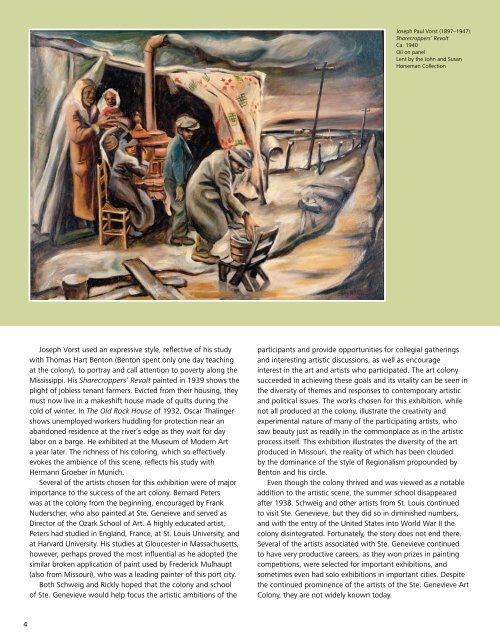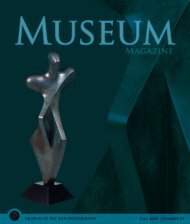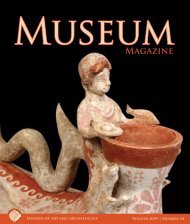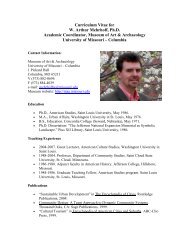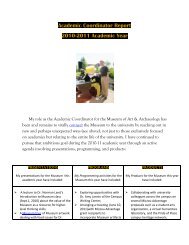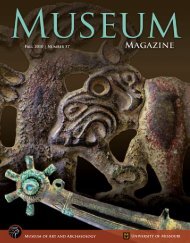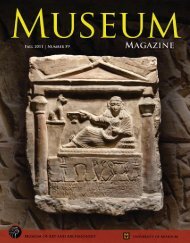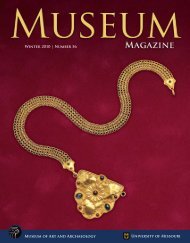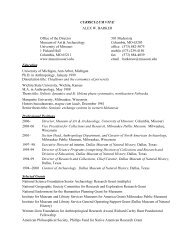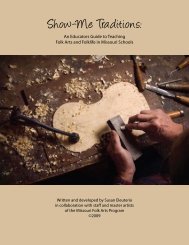Winter 2011 - Museum of Art and Archaeology - University of Missouri
Winter 2011 - Museum of Art and Archaeology - University of Missouri
Winter 2011 - Museum of Art and Archaeology - University of Missouri
- No tags were found...
You also want an ePaper? Increase the reach of your titles
YUMPU automatically turns print PDFs into web optimized ePapers that Google loves.
Joseph Paul Vorst (1897–1947)Sharecroppers’ RevoltCa. 1940Oil on panelLent by the John <strong>and</strong> SusanHorseman CollectionJoseph Vorst used an expressive style, reflective <strong>of</strong> his studywith Thomas Hart Benton (Benton spent only one day teachingat the colony), to portray <strong>and</strong> call attention to poverty along theMississippi. His Sharecroppers’ Revolt painted in 1939 shows theplight <strong>of</strong> jobless tenant farmers. Evicted from their housing, theymust now live in a makeshift house made <strong>of</strong> quilts during thecold <strong>of</strong> winter. In The Old Rock House <strong>of</strong> 1932, Oscar Thalingershows unemployed workers huddling for protection near anab<strong>and</strong>oned residence at the river’s edge as they wait for daylabor on a barge. He exhibited at the <strong>Museum</strong> <strong>of</strong> Modern <strong>Art</strong>a year later. The richness <strong>of</strong> his coloring, which so effectivelyevokes the ambience <strong>of</strong> this scene, reflects his study withHermann Groeber in Munich.Several <strong>of</strong> the artists chosen for this exhibition were <strong>of</strong> majorimportance to the success <strong>of</strong> the art colony. Bernard Peterswas at the colony from the beginning, encouraged by FrankNuderscher, who also painted at Ste. Geneieve <strong>and</strong> served asDirector <strong>of</strong> the Ozark School <strong>of</strong> <strong>Art</strong>. A highly educated artist,Peters had studied in Engl<strong>and</strong>, France, at St. Louis <strong>University</strong>, <strong>and</strong>at Harvard <strong>University</strong>. His studies at Gloucester in Massachusetts,however, perhaps proved the most influential as he adopted thesimilar broken application <strong>of</strong> paint used by Frederick Mulhaupt(also from <strong>Missouri</strong>), who was a leading painter <strong>of</strong> this port city.Both Schweig <strong>and</strong> Rickly hoped that the colony <strong>and</strong> school<strong>of</strong> Ste. Genevieve would help focus the artistic ambitions <strong>of</strong> theparticipants <strong>and</strong> provide opportunities for collegial gatherings<strong>and</strong> interesting artistic discussions, as well as encourageinterest in the art <strong>and</strong> artists who participated. The art colonysucceeded in achieving these goals <strong>and</strong> its vitality can be seen inthe diversity <strong>of</strong> themes <strong>and</strong> responses to contemporary artistic<strong>and</strong> political issues. The works chosen for this exhibition, whilenot all produced at the colony, illustrate the creativity <strong>and</strong>experimental nature <strong>of</strong> many <strong>of</strong> the participating artists, whosaw beauty just as readily in the commonplace as in the artisticprocess itself. This exhibition illustrates the diversity <strong>of</strong> the artproduced in <strong>Missouri</strong>, the reality <strong>of</strong> which has been cloudedby the dominance <strong>of</strong> the style <strong>of</strong> Regionalism propounded byBenton <strong>and</strong> his circle.Even though the colony thrived <strong>and</strong> was viewed as a notableaddition to the artistic scene, the summer school disappearedafter 1938. Schweig <strong>and</strong> other artists from St. Louis continuedto visit Ste. Genevieve, but they did so in diminished numbers,<strong>and</strong> with the entry <strong>of</strong> the United States into World War II thecolony disintegrated. Fortunately, the story does not end there.Several <strong>of</strong> the artists associated with Ste. Genevieve continuedto have very productive careers, as they won prizes in paintingcompetitions, were selected for important exhibitions, <strong>and</strong>sometimes even had solo exhibitions in important cities. Despitethe continued prominence <strong>of</strong> the artists <strong>of</strong> the Ste. Genevieve <strong>Art</strong>Colony, they are not widely known today.4


